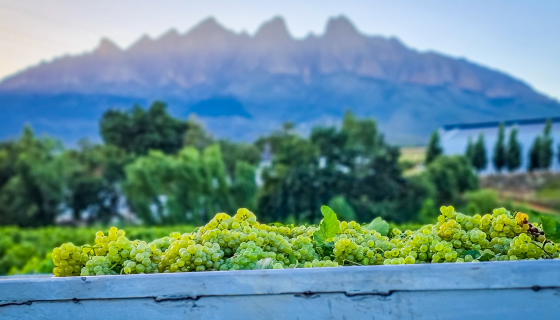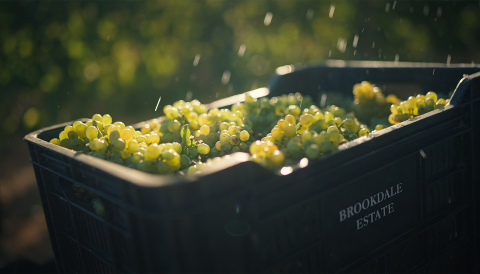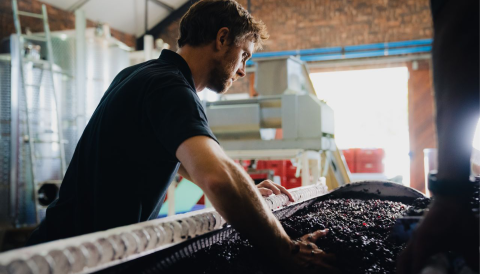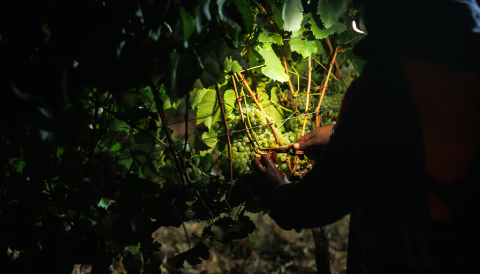South African winegrowers showed characteristic pluck in the face of 2023 harvest challenges. Despite a wet season capped by disruptive late-harvest rains, the vintage is being hailed by respected winemakers and viticulturists for its quality, in particular for whites. ‘If this was your first vintage, it was likely very challenging, but if you understand your site, the moderate season was an advantage’, remarks Carl Schultz, who’s been winemaker at Hartenberg in Stellenbosch for 35 vintages.
According to a collaborative report by industry bodies Vinpro, SAWIS and WOSA, 2023 produced one of smallest crops of the last decade. Part of this decrease is attributed to rolling blackouts (known as load-shedding in South Africa). Eskom, the national energy supplier, is unable to generate enough electricity for the country’s needs, so the power supply is shut down for a certain number of hours each day (sometimes for up to six hours at a time). The inability to irrigate at critical points during the growth phase has led to subsequently smaller crops.
Added to this the more garden-variety issues of high disease pressure, powdery mildew in particular, which was promoted by December rains before veraison, vineyard uprootings as well as heat spikes leading to sunburnt grapes in the inland growing areas.
In general terms, winter in South Africa’s winelands was dry and warm. Budbreak was 7–10 days earlier than usual, and spring and early summer growing conditions were said to be optimal, the abundant rains early in the season just before veraison having aided fruit quality. A cool and wet summer prolonged ripening. Harvest began as per usual at the beginning of February. However, the unseasonal rains that came throughout March had the effect of prolonging harvest into April for many.
Picking decisions and careful vinification for late ripeners, such as Cabernet Sauvignon, was crucial due to the late-harvest rain. However, the season’s length, coolness and reduced yields have contributed to wines with lower alcohol than usual, high acidities and low pHs, all indicators of a fresh, elegant and site-expressive vintage.
Summaries of key winegrowing regions (see this map) follow below.
Coastal region highlights
Constantia
Over half the plantings in this ward of the Cape Town district are Sauvignon Blanc, which were harvested before the March rains at low pHs, high acidities and optimal sugar levels.
Due to the March rains the majority of red varieties were harvested up to three weeks later than the previous year as winemakers waited for the late varieties to ripen. ‘In terms of quality, most of the white cultivars, particularly Sauvignon Blanc, and early red cultivars like Cabernet Franc stood out’, comments viticulturist Etienne Terblanche. ‘Low alcohol levels and extractions as well as high pH levels characterised the late intakes. Strict selection practices should ensure better-than-expected quality, given the challenges with the late cultivars.’
At Klein Constantia, famous for its natural sweet Muscat wine Vin de Constance, vineyard manager Craig Harris recorded 121 mm (4.8 in) of rain in March. ‘Thanks to some aggressive leaf-breaking and regular wind, the grapes survived’, he reports. ‘Muscat has a thick skin, which saved the remaining crop, and sugars climbed slowly til we harvested the last grapes on 18 April for Vin de Constance.’
Much were the same reports from the Cape Town district’s other famous ward, Durbanville. The white cultivars, particularly its flag-bearer Sauvignon Blanc, also thrived in the cool conditions, while early and mid-season red cultivars like Pinotage and Shiraz also show good colour and flavour development.
Darling
Further along the coast, dubbed ‘cool-climate West Coast’, Darling’s vineyards enjoy proximity to the Atlantic Ocean and its moderating effects, and as such the district is known to produce high-quality Sauvignon Blanc and, increasingly, Cinsault.
Nick Pentz, owner of Groote Post, says, ‘2022 was the first in seven years to be of a normal size, following the drought of 2016 to 2018.’ However, the dry winter had the effect of lowering crops again in 2023. White grape varieties were down between 20 and 50% and red varieties by 10–20%. Pentz ascribes the drop in whites in particular to Chardonnay and the variances in crop over the last few years. This he says is a factor of both uneven budding as well as ‘youngish blocks trying to find their feet’.
In the Piekenierskloof, a higher-elevation ward, Cerina van Niekerk of Cecilia Wines says the 2023 vintage started earlier than normal, ‘with early varieties, Chenin Blanc and Pinotage, stealing the show’ and Grenache and Cinsault also standing out.
The heartland
In Stellenbosch, South Africa’s premier region for Cabernet Sauvignon, winemaker Christo Le Riche at Le Riche Wines describes 2023 as ‘a season with two faces’. ‘The first blocks were powerful, ripe and full of flavour’, he says. ‘Then the rains came. The storms slowed harvesting to a crawl. Making the call to pick was difficult.’ Terblanche comments that despite the challenges there was sufficient phenolic development. Expect many of Stellenbosch’s reds to be on the more elegant end of the spectrum.
‘It has been cooler, but in [normally] hot Paarl that was welcome’, says Brookdale’s winemaker Kiara Scott. ‘We got most of our whites in before the heavy rains. For the reds we needed patience.’ Yields on white cultivars such as Sauvignon Blanc, Chardonnay and Chenin Blanc are lower compared with 2022, while Pinotage (especially), Cabernet Sauvignon and Merlot all produced bigger crops.
In Wellington, like neighbouring Paarl ‘… the customary heatwaves stayed away this year’, shares viticulturist Hanno van Schalkwyk. ‘At this early stage, Pinotage, Chenin Blanc and Chardonnay can be highlighted for excellent quality.’ Corlea Fourie, winemaker at Bosman Family Vineyards, agrees: ‘For Wellington, being the early region that it is, the rains were mostly mitigated by the quick start we had. All in all a riper harvest for us, showing good potential.’
From Wellington the landscape unfurls in the Swartland’s characteristic wheat fields and gentle hills. It, too, benefited from the absence of heatwaves. Viticultural consultant and old-vine champion Rosa Kruger is enthusiastic about the vintage: ‘The quality is very good. The crop is a bit lower, approximately 15% from 2022.’
Franschhoek
All early indications were positive, from even flowering to rapid veraison. For Clayton Reabow, cellarmaster at still-wine and Cap Classique producer Môreson, harvest was seamless, with all the grapes in before the March rains. Not everyone was as lucky: some had to look for ‘gap days’ to mitigate the deluge, which sometimes meant picking at lower-than-usual sugar levels. Topography played a role in this mountainous area, and those at higher elevations were hit harder by the rains, such as estates up in the Bo-Hoek.
Breede River Valley
For sparkling-wine producers, 2023 is a terrific vintage. ‘The Chardonnay base wines are bright with precision’, enthuses Pieter Ferreira, cellarmaster at Graham Beck in Robertson. ‘We’ve noted the best natural acidity in the last five years.’ Ferreira says picking was ‘fast and fierce’, beginning 4 January, ending on 21 January. Still whites fared less well, with lower yields due to harvest rains.
In the Breedekloof, Attie Louw of Opstal expresses excitement over the quality of the white wines: ‘February was superb, with Chenin Blanc, Sauvignon Blanc, Sémillon and Pinotage coming in with great concentration of flavour. Crop was down 10%, but the quality was exciting. Then we had the late rains. We’ll need to be savvy with the reds this year, with a focus on light, juicy styles.’
Cape South Coast
2023 was particularly challenging in the high, cool vineyards of the Cape South Coast region. Richard Kershaw MW says it was the coolest vintage he’s experienced since he started his eponymous label in Elgin in 2012. ‘We started picking towards the middle of March, by which time the rains had already started. Sauvignon is lower in alcohol, with lower intensities in comparison to Sémillon, where the intensity is off the charts.’ The wind was also challenging, stripping leaves, which further slowed down photosynthesis. On the plus side, he says, the majority of the Pinot Noir (60%) was picked before the rains and ‘was absolutely stunning’. Chardonnay, too, gets a punt, and Kershaw is excited about the Riesling.
‘“Caught inside” is a surfing expression for when a set of waves is about to break on your head, an apt analogy for the 2023 harvest’, comments Gordon Newton Johnson, winemaker of his titular family estate located high up in the cool, coastal Hemel-en-Aarde Valley. ‘It was a constant search for picking windows and balancing the risk of rot versus the need for physiological ripeness.’
Overall yields were down compared with the previous, above-average crop, influenced heavily by low yields of Chardonnay (uneven budding as well as late-season rot). The inclement weather notwithstanding, the valley’s flagship cultivars, Chardonnay and Pinot Noir, are said to be of outstanding quality with expectations of balanced wines with low alcohols, good acidity and high aromatic potential.
For many more articles on South African wine, see here.




















